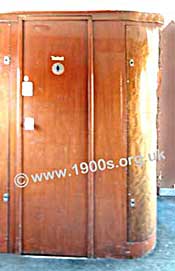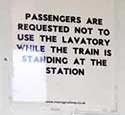
Toilets in trains in 1940s wartime UK
Lavatories in early trains seem to have been called toilets in some situations and lavatories in others. This page uses the term interchangeably. It explains why they were to be avoided and describes the alternatives open to passengers on train without corridors - which meant no toilets - or when the toilets were out of order.
____
By the webmaster based on her early recollections with additional research and firsthand contributions
Corridor-trains did have lavatories, sometimes labelled as toilets. One was situated at the end of most carriages.
Location and appearance of the toilets
The toilets were in cubicles made or faced with dark wood, as was so much in the era before man-made materials.

Toilet cubicle at the end of a corridor on an old train*
Why these lavatories were to be avoided
The lavatories always seemed to smell, were usually out-of-order, and were to be avoided if at all possible. This state of affairs went on for some years after the war as Britain did not recover quickly. The smell was largely due to the fact that although the lavatories did flush, their water tanks were usually empty and there was seldom any toilet paper or torn squares of newspaper.
The contents of passengers' visits to the train toilets
The contents of passengers' visits flushed - or dropped - directly onto the train lines. Not surprisingly, there were notices stating that the lavatories were not to be used while a train was in a station.

Notice in an early train, requesting passengers to refrain from using the lavatory - this time not toilet - while the train was in a station. Photographed on a Swanage Heritage Line train.
The cubicles locked with a bolt. How many times had people used this without washing their hands?!
The window as the toilet
Many of the trains were just compartments with no corridors. They were intended for short local journeys, but with the deprivations of the Second World War, this was not always possible. So even some long distance trains had no toilets. Other trains had broken ones, and sometimes they were occupied for long periods. So what were passengers to do when their needs arose?
Most passengers just put up with it somehow, but there was another solution - for men, but not women - because the train window in the compartment door could be opened. Read on ...
Maintaining dignity while using the window as a toilet
On a long journey in 1945 I was with two other ATS* girls in a train with no corridor and hence no toilet. In our carriage were three young sailors full of beer, and one needed relief. So the sailors opened the window and shoved their tipsy mate to the opening. Then because there were girls present, they held a great coat over his back so we couldn't see. In that way he was able to pee out of the open window.
Kath O'Sullivan (formerly Margerison)
North District Signal Corps,
*The Auxiliary Territorial Service (ATS)
Army number W 307782
Getting a shower while using the window as a toilet
One time I took the night train to London amid an enormous number of sailors who were going on shore leave after their ship had paid off at Plymouth. As they had had much of the day to celebrate and were flush with pay, they had had their full of drinking and were sitting, standing, singing, arguing, shouting and moving up and down the packed corridors.
At one point, a very indignant sailor came along the corridor fulminating at the ticket inspector. It turned out that the sailor had needed to drain his bladder and the toilet had been 'Engaged'. However he found that by standing on tip toe he could carry out the operation through the open window of the train door outside the toilet.
While busying himself in this way, the ticket inspector came through the corridor connector, put his hand on the sailor's shoulder and pulled him back down onto his feet. The result was that the sailor ended up with a very wet front to his carefully pressed bell bottoms*.
Malcolm Keen
*The loose trousers that sailors wore were informally known as 'bell bottoms'.
A ditty about train lavatories sung in WW2 forces
My apologies that I can't remember all the words, but I do remember that the following ditty was sung to a classical tune.
Passengers are please requested to refrain from passing water
When the train is in the station ... I love you.
We encourage constipation when the train is in the station
.... I love you.
Kath O'Sullivan (formerly Margerison)
North District Signal Corps,
*The Auxiliary Territorial Service (ATS)
Army number W 307782
Having compared a rendition of this on YouTube to songs available after searching the lyrics, I believed that I had found what Kath O'Sullivan was referring to. Sadly now it no longer seems to be available. It was a nice tune, even if the lyrics leave something to be desired!
Wikipedia refers to Dvořák's Humoresque Number 7 as the tune for several songs of a similar nature in the United States.
Robin Denham
Text and images are copyright
*Photographed by the webmaster on a Swanage Heritage Line train
sources: early 20th century material
sources: ww2 home front and other material
contact
the webmaster/author/researcher/editor
privacy policy
















